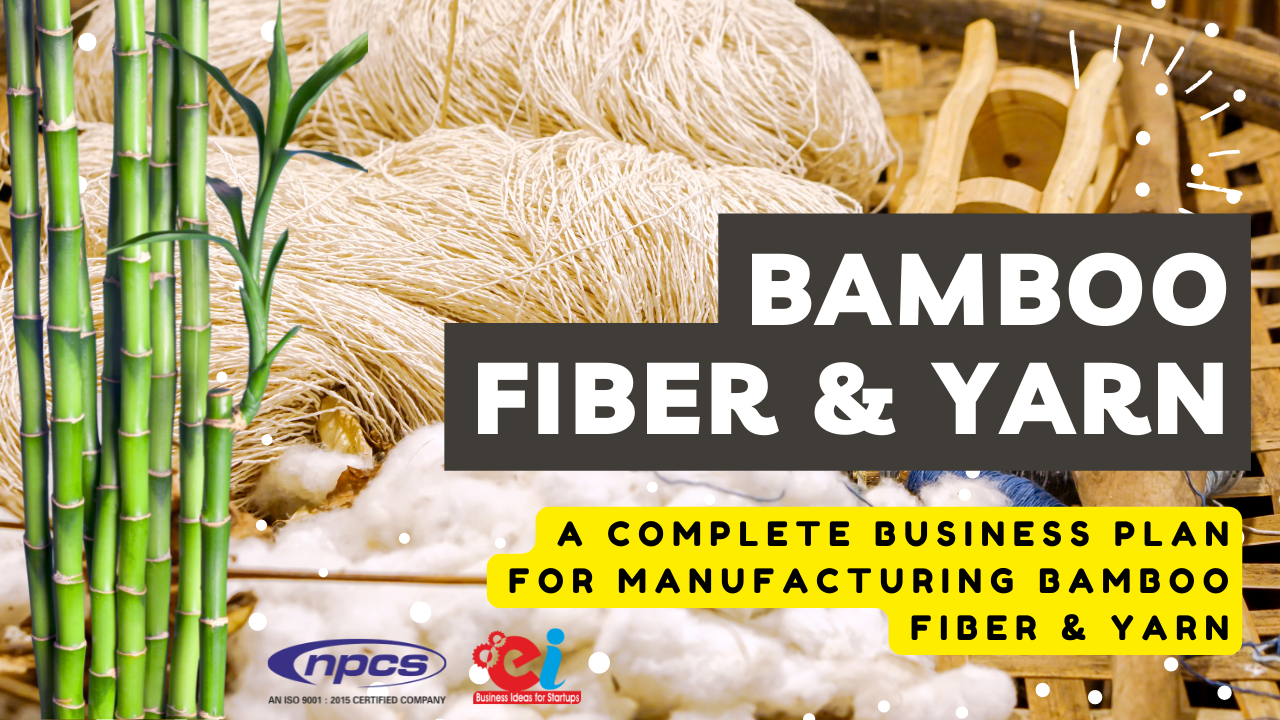Bamboo fiber yarn is fast becoming a cornerstone in the world of eco-conscious textiles. As industries shift toward more sustainable and ethical practices, bamboo-based materials are emerging as an attractive alternative to traditional synthetic and cotton fibers. Starting a bamboo fiber yarn business not only taps into this growing demand but also contributes positively to the environment by offering a renewable, biodegradable, and highly versatile product.
This comprehensive guide will take you through every essential step of launching your bamboo fiber yarn venture—from understanding the market and setting up the production facility to branding and scaling your operations.
The Bamboo Fiber Yarn Market – An Eco-Friendly Revolution
The textile industry is undergoing a significant transformation. Consumers are becoming more aware of the ecological impact of their choices, demanding materials that are not just stylish and comfortable but also sustainable. Bamboo fiber yarn perfectly meets these criteria. Derived from the cellulose of bamboo plants, this yarn boasts natural antibacterial properties, UV resistance, moisture-wicking capabilities, and a soft texture similar to silk or cashmere.
Globally, the demand for eco-friendly yarns is increasing, especially in developed regions like Europe, North America, and parts of Asia. Bamboo yarn is used in making garments, towels, baby clothing, home textiles, and even medical fabrics. Launching a business in this space means capitalizing on a product that is both trendy and environmentally responsible.
Step-by-Step Plan to Start a Bamboo Fiber Yarn Business
1. Market Research and Feasibility Analysis
Before entering any business, a deep understanding of the market is crucial. Study the domestic and international demand for bamboo yarn. Look into who your potential customers will be—garment manufacturers, weavers, eco-conscious brands, or direct consumers. Identify the size of your target market, pricing patterns, consumption trends, and major players.
Additionally, analyze production trends and raw material sourcing options. India, China, and Southeast Asia have an abundance of bamboo resources, making them ideal for raw material procurement. Also, look into trade policies, import/export laws, and government schemes supporting bamboo-based industries.
2. Create a Robust Business Plan
A well-structured business plan serves as the backbone of your venture. It guides your strategy and attracts potential investors. Your business plan should include:
- Executive Summary: Overview of your business goals and mission
- Market Analysis: Trends, competitor study, and customer segmentation
- Products and Services: Details on the types of bamboo yarn you’ll offer—combed, carded, dyed, blended, etc.
- Operations Plan: Description of production processes and logistics
- Marketing and Sales Plan: Strategy for brand positioning, pricing, and distribution
- Financial Forecasts: Projected revenues, break-even analysis, and funding needs
3. Choose the Right Business Model
You can operate under various business models depending on your budget and vision:
- Manufacturing-Based Model: Involves full production from raw bamboo to finished yarn. High investment, full control.
- Outsourcing Model: You outsource production to third-party manufacturers and focus on branding, packaging, and distribution.
- Wholesale/Retail Model: Buy bulk bamboo yarn and sell to retailers or consumers.
- Online DTC Model: Set up your eCommerce store and sell bamboo yarn directly to end users.
Each model has its pros and cons. Choose the one that matches your capital, expertise, and long-term goals.
4. Legal Compliance and Licensing
Operating a bamboo fiber yarn business legally requires registration and compliance with local laws. Obtain:
- Company Registration (Sole Proprietorship, LLP, or Private Limited Company)
- GST Registration
- Trade License from your municipality
- Import-Export Code (for international trade)
- Pollution Control Board License (if required)
- Textile Industry Certifications such as OEKO-TEX®, GOTS, or ISO
These certifications also enhance your credibility in global markets.
5. Setting Up the Manufacturing Facility
To produce bamboo fiber yarn, you need a facility equipped with advanced machinery and a streamlined production line. The primary steps include:
- Bamboo Pulping: Raw bamboo is chopped and chemically or mechanically processed to create pulp.
- Fiber Extraction: The pulp is treated and spun into fibers.
- Carding and Spinning: The fibers are aligned and twisted into yarn.
- Dyeing and Finishing: Yarns are dyed naturally or synthetically, then dried and finished.
- Packaging: The final yarn is packaged for wholesale or retail use.
Essential Machinery Includes:
- Bamboo cutting and grinding machines
- Steam cooking tanks and chemical treatment vats
- Fiber extractors and carding machines
- Ring spinning or open-end spinning machines
- Dyeing vessels and drying chambers
- Packaging and winding machines
6. Sourcing Raw Materials
Sourcing quality raw bamboo is critical. Partner with certified organic bamboo cultivators who practice sustainable farming. In India, states like Assam, Mizoram, Tripura, and parts of Karnataka and Maharashtra offer vast bamboo plantations. Ensure that your supply chain is ethical and environmentally sustainable.
You may also explore partnerships with bamboo cooperatives and forest departments to get bulk raw material at affordable rates.
Marketing Strategy for Bamboo Fiber Yarn Business
1. Develop a Green and Responsible Brand
Your branding should strongly highlight your sustainable values. Use eco-friendly materials for packaging. Tell your brand story—how your yarn helps reduce environmental impact. Highlight features like:
- 100% biodegradable
- Hypoallergenic and breathable
- Sustainably harvested
- Fair-trade and cruelty-free
2. Build a Strong Digital Presence
Having an SEO-optimized website is essential. Use your primary keyword, “bamboo fiber yarn,” at least seven times throughout your site. Optimize for other related terms like organic yarn, eco-friendly fibers, sustainable textile material, etc. Include:
- Product pages with detailed descriptions
- Blog content focused on sustainable fashion and DIY projects
- Customer testimonials and case studies
- Tutorials on using bamboo yarn
Don’t forget to list on online marketplaces like Amazon, Etsy, IndiaMART, and Shopify.
3. Social Media and Influencer Marketing
Use platforms like Instagram, Pinterest, and Facebook to showcase the aesthetic appeal of your yarn and its uses. Collaborate with influencers in the eco-fashion and crafts niche. Host giveaways and user-generated content campaigns to increase visibility.
4. Target B2B Clients
Attend textile expos, sustainability summits, and trade fairs. Distribute samples and product catalogs to manufacturers, wholesalers, and designers. Offer customized solutions, bulk discounts, and white-label opportunities.
Financial Projections and Cost Estimation
| Cost Head | Estimated Investment (INR) |
|---|---|
| Land and Infrastructure | ?20–30 Lakhs |
| Machinery and Equipment | ?40–60 Lakhs |
| Raw Material Procurement | ?10–15 Lakhs |
| Skilled Labor and Operations | ?5–10 Lakhs/month |
| Branding and Marketing | ?3–5 Lakhs |
| Certifications & Compliance | ?2–3 Lakhs |
Break-even is typically achievable within 2 to 3 years, provided you have efficient operations, proper financial planning, and a strong market presence.
Growth Potential and Expansion
The future of the bamboo fiber yarn business is bright. Global awareness around climate change and sustainability is pushing large brands to seek green alternatives. You can diversify into:
- Bamboo blended fabrics (cotton-bamboo, wool-bamboo)
- Bamboo clothing line (innerwear, T-shirts, activewear)
- Bamboo-based home furnishings (sheets, towels, curtains)
- Export markets in the USA, UK, EU, and Australia
You may also explore vertical integration by setting up your own weaving or garment manufacturing unit to capture more value.
Conclusion
Starting a bamboo fiber yarn business is not just a lucrative opportunity—it’s a meaningful step towards creating a sustainable future. With the right strategy, infrastructure, and commitment to environmental ethics, your brand can become a leader in the eco-textile revolution. As demand continues to rise, early entrants will benefit from brand loyalty, higher margins, and global reach.
Visit the page Select and Choose the Right Business Startup for You for sorting out the questions arising in your mind before starting any business and know which start-up you can plan.
We, at NPCS, endeavor to make business selection a simple and convenient step for any entrepreneur/startup. Our expert team, by capitalizing on its dexterity and decade’s long experience in the field, has created a list of profitable ventures for entrepreneurs who wish to diversify or venture. The list so mentioned is updated regularly to give you a regular dose of new emerging opportunities.






